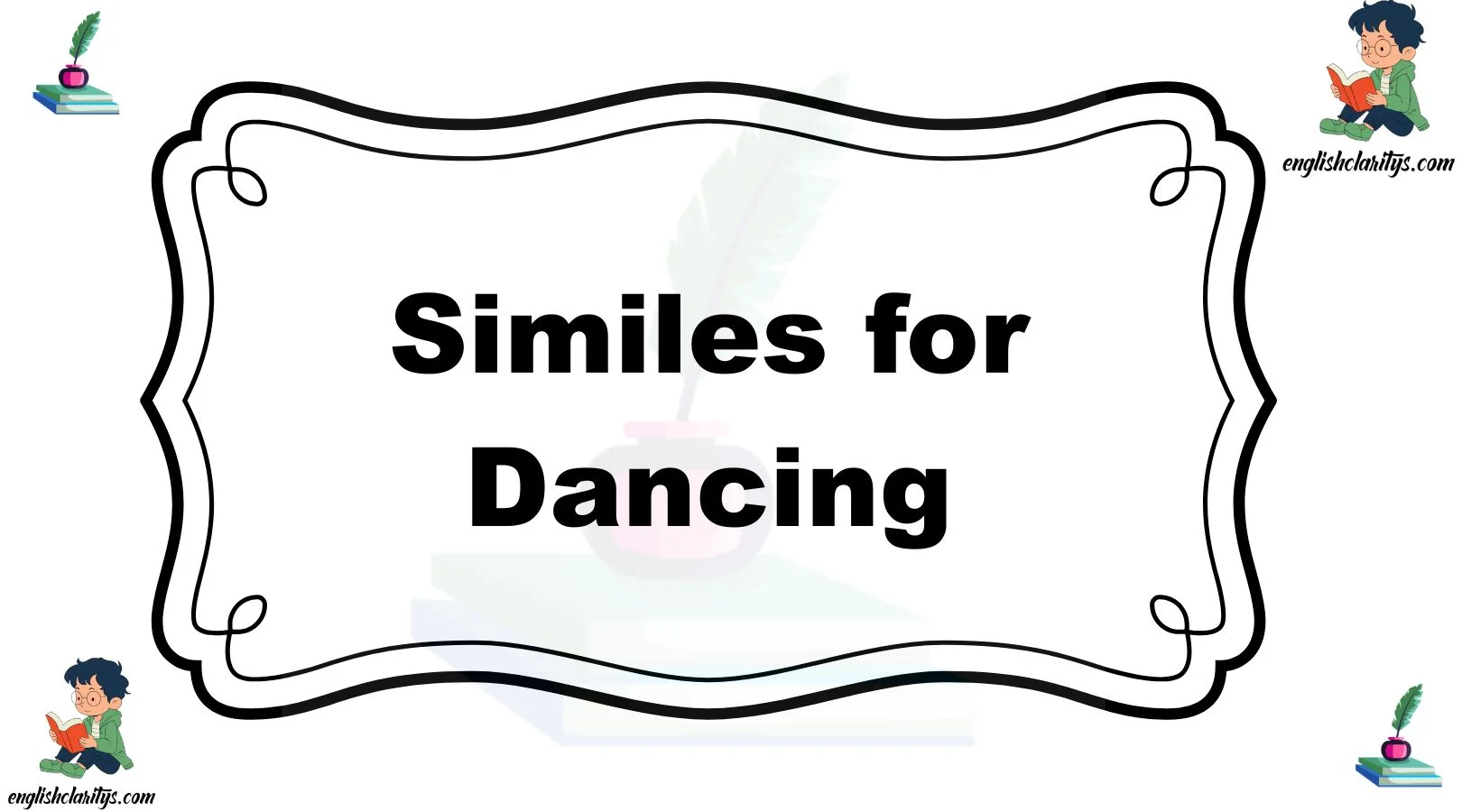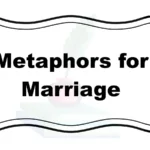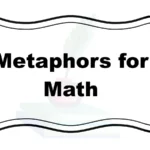Expressing how someone dances can be a beautiful way to show appreciation and admiration. Finding the right words not only paints a vivid picture but also conveys warmth and care in a message.
Using similes for dancing helps capture the elegance, energy, or joy in movement, making your expression more personal and meaningful. Whether you’re complimenting a friend, writing creatively, or sharing your feelings, these similes will enrich your vocabulary and brighten your communication.
What Does “Similes for Dancing” Mean?
A simile is a figure of speech that compares two different things using the words “like” or “as” to create vivid imagery. When we talk about similes for dancing, we describe dancing by likening it to something familiar, helping others visualize the style, feeling, or mood of the dance. For example, saying “She dances like a leaf in the wind” evokes lightness and grace.
When to Use “Similes for Dancing”
You can use similes for dancing in various situations:
- Complimenting someone’s dance performance or style.
- Writing poetry, stories, or song lyrics.
- Giving speeches or presentations about dance or movement.
- Sharing emotions or memories related to dancing.
- Adding flair and warmth to casual conversations about dance.
Using similes thoughtfully brings your words to life, making your message more engaging and heartfelt.
Pros and Cons of Using Similes for Dancing
Pros:
- Enhances visualization: Helps the listener or reader see the dance more clearly.
- Adds emotional depth: Connects the physical act of dancing to feelings or moods.
- Engages creativity: Makes communication lively and memorable.
Cons:
- Can be misunderstood: If the simile is too obscure or complex.
- May seem cliché: If overused or predictable.
- Context dependent: Some similes fit certain dance styles better than others.
1. Dances like a leaf in the wind
Definition: Movement is light, graceful, and flowing.
Detailed Explanation: This simile compares dancing to the gentle, unpredictable flutter of a leaf carried by the wind. It suggests softness and effortless movement.
Scenario Example: Watching her sway on stage, she danced like a leaf in the wind, captivating everyone with her gentle grace.
Best Use: Ballet, contemporary, or slow dances emphasizing fluidity.
Tone: Poetic, gentle, admiring.
Other Ways to Say It:
- Moves like a feather drifting.
- Glides like a cloud in the sky.
- Floats like a petal on water.
2. Dances like a flame flickering
Definition: Movement is lively, dynamic, and unpredictable.
Detailed Explanation: Like a flame that dances with bright, quick, and ever-changing motions, this simile describes energetic and passionate dance.
Scenario Example: His salsa moves were fiery; he danced like a flame flickering in the night.
Best Use: Latin, jazz, or fast-paced energetic dances.
Tone: Vibrant, passionate, intense.
Other Ways to Say It:
- Moves like sparks flying.
- Twirls like firelight in darkness.
- Swirls like wildfire.
3. Dances like waves on the ocean
Definition: Movement is smooth, rhythmic, and continuous.
Detailed Explanation: This simile draws a parallel between dancing and the natural, rhythmic rise and fall of ocean waves, implying flow and natural grace.
Scenario Example: Her dance was mesmerizing, like waves on the ocean—steady and calming.
Best Use: Waltz, lyrical, or any fluid, repetitive dance.
Tone: Calm, soothing, mesmerizing.
Other Ways to Say It:
- Moves like tides rolling in.
- Sways like the sea breeze.
- Flows like a gentle stream.
4. Dances like a hummingbird hovering
Definition: Movement is quick, precise, and delicate.
Detailed Explanation: Like a hummingbird’s rapid wing flaps and sudden stops, this simile captures quick, agile, and light-footed dancing.
Scenario Example: She danced like a hummingbird hovering—swift and full of energy.
Best Use: Tap dance, quickstep, or energetic solo dances.
Tone: Light, energetic, playful.
Other Ways to Say It:
- Moves like a butterfly fluttering.
- Twinkles like a firefly.
- Flits like a sparrow.
5. Dances like a river flowing
Definition: Movement is smooth, natural, and continuous.
Detailed Explanation: This simile likens dancing to the continuous and steady flow of a river, emphasizing grace and unbroken motion.
Scenario Example: His movements were natural, dancing like a river flowing freely through rocks.
Best Use: Contemporary, modern, or expressive dance forms.
Tone: Peaceful, fluid, natural.
Other Ways to Say It:
- Glides like a stream.
- Rolls like a gentle current.
- Moves like water over stones.
6. Dances like fireflies at dusk
Definition: Movement is light, scattered, and enchanting.
Detailed Explanation: Like fireflies flashing intermittently at twilight, this simile paints a picture of delicate, magical, and fleeting dance moves.
Scenario Example: The group performed with charm, dancing like fireflies at dusk—brief and beautiful flashes of light.
Best Use: Group dances, folk dances, or whimsical choreography.
Tone: Enchanting, whimsical, charming.
Other Ways to Say It:
- Moves like twinkling stars.
- Flickers like candlelight.
- Glimmers like morning dew.
7. Dances like the wind through trees
Definition: Movement is gentle, natural, and unpredictable.
Detailed Explanation: This simile suggests flowing and spontaneous motion, much like how the wind rustles tree leaves unpredictably yet softly.
Scenario Example: She swayed effortlessly, dancing like the wind through trees on a spring day.
Best Use: Interpretive dance, ballet, or freestyle.
Tone: Soft, natural, free.
Other Ways to Say It:
- Moves like a breeze over grass.
- Flows like a soft sigh.
- Swirls like autumn leaves.
8. Dances like a cat stalking
Definition: Movement is smooth, stealthy, and controlled.
Detailed Explanation: This simile highlights careful, deliberate, and graceful movements akin to a cat’s stealthy approach.
Scenario Example: His hip-hop style was sharp and precise, dancing like a cat stalking its prey.
Best Use: Hip-hop, breakdance, or any dance requiring sharp control.
Tone: Cool, confident, controlled.
Other Ways to Say It:
- Moves like a panther prowling.
- Slips like a shadow.
- Glides like a ninja.
9. Dances like sparks flying
Definition: Movement is quick, bright, and exciting.
Detailed Explanation: Like sparks shooting out from a fire, this simile suggests bursts of energy and vibrant movement.
Scenario Example: The flamenco dancer’s feet flew, dancing like sparks flying from a fire.
Best Use: Flamenco, jazz, or any fast and lively dance.
Tone: Exciting, energetic, fiery.
Other Ways to Say It:
- Moves like lightning flashes.
- Twists like a flame’s edge.
- Flashes like fireworks.
10. Dances like silk in the breeze
Definition: Movement is smooth, soft, and elegant.
Detailed Explanation: This simile evokes the image of silk fabric gently fluttering, symbolizing elegance and fluidity.
Scenario Example: Her ballroom moves were elegant, dancing like silk in the breeze.
Best Use: Ballroom, ballet, or slow dances.
Tone: Elegant, graceful, refined.
Other Ways to Say It:
- Moves like satin flowing.
- Glides like velvet ribbons.
- Floats like chiffon.
11. Dances like a whirlwind
Definition: Movement is fast, intense, and powerful.
Detailed Explanation: Comparing dance to a whirlwind emphasizes energy and rapid, sweeping motions.
Scenario Example: He spun across the floor, dancing like a whirlwind that couldn’t be stopped.
Best Use: Breakdance, fast-paced dances.
Tone: Energetic, powerful, overwhelming.
Other Ways to Say It:
- Moves like a storm.
- Spins like a tornado.
- Whirls like a cyclone.
12. Dances like a gentle breeze
Definition: Movement is soft, calm, and flowing.
Detailed Explanation: Like a soft breeze, this simile indicates smooth and relaxed motion.
Scenario Example: She moved across the stage like a gentle breeze, soothing and calm.
Best Use: Slow dance, lyrical.
Tone: Peaceful, soothing, tender.
Other Ways to Say It:
- Flows like a whisper.
- Moves like a caress.
- Glides like a feather.
13. Dances like a gazelle leaping
Definition: Movement is quick, light, and agile.
Detailed Explanation: This simile highlights quickness, grace, and athleticism.
Scenario Example: His moves were sharp and fast, dancing like a gazelle leaping across the savanna.
Best Use: Hip-hop, jazz, or athletic dance styles.
Tone: Agile, energetic, athletic.
Other Ways to Say It:
- Moves like a deer bounding.
- Springs like a panther.
- Jumps like a rabbit.
14. Dances like a shadow slipping
Definition: Movement is smooth, silent, and elusive.
Detailed Explanation: This simile reflects subtle and sleek movements.
Scenario Example: She glided across the floor, dancing like a shadow slipping through the night.
Best Use: Contemporary, lyrical.
Tone: Mysterious, elegant, quiet.
Other Ways to Say It:
- Moves like mist.
- Flows like smoke.
- Glides like a ghost.
15. Dances like petals falling
Definition: Movement is slow, soft, and delicate.
Detailed Explanation: This simile describes slow, gentle movements like petals drifting to the ground.
Scenario Example: Her performance was tender, dancing like petals falling in the wind.
Best Use: Ballet, slow interpretive dances.
Tone: Gentle, emotional, delicate.
Other Ways to Say It:
- Moves like snowflakes drifting.
- Flows like rain drops.
- Falls like feathers.
16. Dances like lightning across the sky
Definition: Movement is fast, dazzling, and electrifying.
Detailed Explanation: This simile likens a dancer’s moves to lightning—sudden, bright, and impactful. It suggests a performance full of speed and intensity.
Scenario Example: The breakdancer lit up the stage, dancing like lightning across the sky.
Best Use: Street dance, breakdancing, or high-speed choreography.
Tone: Powerful, thrilling, sharp.
Other Ways to Say It:
- Moves like an electric spark
- Dances like a thunderclap
- Jumps like a flash
17. Dances like moonlight on water
Definition: Movement is soft, gentle, and mesmerizing.
Detailed Explanation: This simile paints a dreamy image of calm, reflective beauty, ideal for romantic or serene dances.
Scenario Example: Her solo performance was tender and ethereal, like moonlight on water.
Best Use: Ballet, contemporary, or romantic performances.
Tone: Serene, dreamy, reflective.
Other Ways to Say It:
- Moves like morning dew
- Shimmers like candlelight
- Glides like mist
18. Dances like thunder rolling
Definition: Movement is heavy, powerful, and commanding.
Detailed Explanation: This simile conveys strength and boldness, ideal for powerful group choreography or percussive dance.
Scenario Example: The ensemble shook the stage, dancing like thunder rolling in the distance.
Best Use: Step, stomp, or power-packed group performances.
Tone: Commanding, dramatic, intense.
Other Ways to Say It:
- Moves like a drumbeat
- Pounds like a war chant
- Rumbles like an earthquake
19. Dances like a puppet on strings
Definition: Movement is deliberate, jerky, and animated.
Detailed Explanation: This simile suggests robotic or mechanical motion, often used for humorous or creative performances.
Scenario Example: He danced like a puppet on strings, each move exaggerated and precise.
Best Use: Pantomime, pop-locking, comedic routines.
Tone: Playful, theatrical, controlled.
Other Ways to Say It:
- Moves like a wind-up toy
- Dances like an automaton
- Bops like a cartoon
20. Dances like falling snow
Definition: Movement is gentle, peaceful, and delicate.
Detailed Explanation: Snow falls softly and silently, and this simile reflects a calm, ethereal quality in movement.
Scenario Example: The winter-themed ballet was poetic—she danced like falling snow.
Best Use: Ballet, lyrical, or seasonal performances.
Tone: Soft, quiet, graceful.
Other Ways to Say It:
- Glides like frost on glass
- Twirls like a snowflake
- Falls like a feather
21. Dances like a puppet breaking free
Definition: Movement is chaotic, expressive, and uninhibited.
Detailed Explanation: This simile captures the sudden release of control and burst of freedom, perfect for avant-garde or emotional performances.
Scenario Example: At the climax, she danced like a puppet breaking free—raw and powerful.
Best Use: Interpretive, expressive modern dance.
Tone: Raw, emotional, liberating.
Other Ways to Say It:
- Moves like a soul unchained
- Dances like a storm unleashed
- Twists like a wildfire
22. Dances like a ballerina in a music box
Definition: Movement is poised, graceful, and consistent.
Detailed Explanation: Like the rotating figure in a music box, this simile implies elegance, balance, and charm.
Scenario Example: She danced like a ballerina in a music box—delicate and perfect.
Best Use: Classical ballet or traditional forms.
Tone: Graceful, timeless, sweet.
Other Ways to Say It:
- Spins like porcelain
- Twirls like a wind chime
- Moves like a lullaby
23. Dances like clockwork gears
Definition: Movement is precise, timed, and synchronized.
Detailed Explanation: Comparing dancing to the precise movements of gears, this simile is perfect for synchronized group performances.
Scenario Example: The crew moved as one, dancing like clockwork gears turning in harmony.
Best Use: Group choreography, robotics, or synchronized routines.
Tone: Mechanical, impressive, structured.
Other Ways to Say It:
- Moves like a machine
- Turns like a puzzle
- Clicks like a lock
24. Dances like a feather caught in a breeze
Definition: Movement is airy, spontaneous, and light.
Detailed Explanation: Feathers caught in the wind move unpredictably but softly, suggesting playful freedom.
Scenario Example: She was full of wonder, dancing like a feather caught in a breeze.
Best Use: Contemporary, interpretive, or joyful solos.
Tone: Light, carefree, whimsical.
Other Ways to Say It:
- Floats like dandelion fluff
- Sways like paper in the wind
- Twirls like a ribbon
25. Dances like poetry in motion
Definition: Movement is expressive, beautiful, and meaningful.
Detailed Explanation: This well-loved simile describes a dancer whose every move tells a story—fluid, elegant, and full of expression.
Scenario Example: Every step she took was meaningful—she danced like poetry in motion.
Best Use: Any emotionally rich performance.
Tone: Poetic, expressive, heartfelt.
Other Ways to Say It:
- Moves like a dream
- Dances like a story unfolding
- Glides like a painter’s brush stroke
Conclusion:
Using similes for dancing is a beautiful way to express the nuances of movement, emotion, and style. These comparisons help us convey admiration and affection in a way that feels vivid, personal, and heartfelt. Whether describing a dancer who moves like a leaf in the wind or like poetry in motion, similes add depth and warmth to our words. They invite others to see, feel, and connect with the dance beyond just the physical steps. By choosing the right simile, you bring your expression to life—making your message more memorable and meaningful. So next time you want to celebrate someone’s dance, try a simile that captures their unique rhythm and spirit, and watch your words truly shine.
MCQs:
1. What does the simile “dances like a leaf in the wind” suggest?
a) Strong and forceful movements
b) Robotic and stiff movements
c) Light and graceful movements
d) Fast and jerky movements
2. Which simile best describes quick and precise dancing?
a) Dances like a gentle breeze
b) Dances like a hummingbird hovering
c) Dances like moonlight on water
d) Dances like petals falling
3. “Dances like waves on the ocean” implies:
a) Sudden bursts of energy
b) Smooth and rhythmic movement
c) Slow and awkward steps
d) Jerky and mechanical motions
4. A dancer described as “dancing like sparks flying” likely moves:
a) Gracefully and slowly
b) Smoothly and softly
c) Brightly and energetically
d) Elegantly and quietly
5. What kind of movement does “dances like a cat stalking” imply?
a) Loud and expressive
b) Clumsy and rushed
c) Smooth and controlled
d) Fast and scattered
6. Which simile suggests chaotic and expressive motion?
a) Dances like silk in the breeze
b) Dances like a puppet breaking free
c) Dances like a ballerina in a music box
d) Dances like a clockwork gear
7. Dancing like moonlight on water creates a feeling of:
a) Aggression
b) Intensity
c) Dreaminess
d) Nervousness
8. Which simile suits a powerful and intense group performance?
a) Dances like falling snow
b) Dances like thunder rolling
c) Dances like a feather in the breeze
d) Dances like a shadow slipping
9. What’s the best simile for a dancer with robotic and jerky movements?
a) Dances like a puppet on strings
b) Dances like a river flowing
c) Dances like moonlight
d) Dances like petals falling
10. “Dances like lightning across the sky” implies:
a) Slow and elegant motion
b) Fast and electrifying movement
c) Static and soft expression
d) Gentle and delicate steps
11. What does “dances like a ballerina in a music box” convey?
a) Wildness and freedom
b) Goofy and silly movement
c) Poised and consistent elegance
d) Chaotic and fast rhythms
12. Which simile would best describe unpredictable, floating movement?
a) Dances like thunder rolling
b) Dances like poetry in motion
c) Dances like a feather caught in a breeze
d) Dances like clockwork gears
13. “Dances like clockwork gears” implies:
a) Delicate and flowing steps
b) Completely freestyle dancing
c) Precise and synchronized movement
d) Soft and dreamy expression
14. What’s the best use of the simile “dances like poetry in motion”?
a) To describe emotionless movements
b) To describe powerful, rigid moves
c) To highlight emotional and expressive dance
d) To emphasize silence
15. Why are similes useful in describing dance?
a) They confuse the meaning
b) They replace all verbs
c) They add vivid imagery and emotion
d) They limit creativity in writing
Answers:
- c) Light and graceful movements
- b) Dances like a hummingbird hovering
- b) Smooth and rhythmic movement
- c) Brightly and energetically
- c) Smooth and controlled
- b) Dances like a puppet breaking free
- c) Dreaminess
- b) Dances like thunder rolling
- a) Dances like a puppet on strings
- b) Fast and electrifying movement
- c) Poised and consistent elegance
- c) Dances like a feather caught in a breeze
- c) Precise and synchronized movement
- c) To highlight emotional and expressive dance
- c) They add vivid imagery and emotion
FAQs:
1. Why should I use similes to describe dancing?
Similes make your descriptions more vivid, emotional, and memorable. They help readers or listeners visualize the movement, mood, and style of a dancer, going beyond literal descriptions. Whether you’re complimenting someone or writing creatively, similes add warmth and color to your language.
2. Can similes be used in formal writing about dance?
Yes—when used thoughtfully, similes can enhance formal writing. In dance reviews, academic analysis, or descriptive essays, similes can help convey the artistry and feeling behind the performance. Just ensure the tone and context match your audience and purpose.
3. What makes a simile effective when describing dance?
An effective simile is clear, relatable, and emotionally accurate. It connects the dance movement to a familiar image or concept that enhances understanding. The best similes balance creativity with clarity, making sure the comparison fits the dancer’s style and tone.
4. Are similes and metaphors the same thing?
Not quite. Similes use the words “like” or “as” to make comparisons (e.g., She danced like a flame), while metaphors directly equate two things without using “like” or “as” (e.g., She was a flame on stage). Both are valuable tools, but similes are generally easier to interpret and often more conversational.
5. How can I create my own simile for dancing?
Start by observing the dancer’s style, rhythm, emotion, and energy. Then think of natural elements, animals, or objects that share those qualities. Use the format “dances like…” to form your simile. For example, if a dancer is graceful and smooth, you might say “dances like water gliding over stone.”




